Kia ora and welcome to the end of another week. Here’s our regular Friday roundup of things that caught our eye, in the realm of cities and transport. If you enjoy these roundups, feel free to join our growing ranks of supporters by making a recurring donation to keep the good work coming! Think of it as shouting us a coffee while you read.
Today’s header image by Scott Caldwell shows the fresh coat of paint on Karanga-ā-hape Road’s famous rainbow crossing.
The Week in Greater Auckland
This week we got a shout-out from RNZ’s Mediawatch, re Matt’s coverage of the latest announcement on road safety. In a segment called “Cutting through the spin – or not“, Hayden Donnell noted: “For all our news organisations’ talk about cutting through the spin, the blade has sometimes been a little bit blunt.”
He gave the counter-example of yours truly:
One outlet didn’t report it with a crackdown-infused headline on impaired drivers. The Greater Auckland blog titled its piece on the government’s latest transport announcement ‘road policing reduction’.
“It’s being presented as a brand new passage of new funding that’s coming in, but if you look at the detail it’s actually a reduction,” director Matt Lowrie told Mediawatch. Lowrie said before publishing, the media needed to ask whether the funding being announced is new, and if not, where it’s coming from.
“Road safety is a really critical issue in New Zealand. If we’re seeing the government reduce funding, we should have that reported.”
We catch things other media misses! This week on the blog:
- Monday’s guest post by Shaun Baker looked at designing cities so as to embrace and empower those with neurodiversity
- Tuesday’s post by Matt looked at next steps for the Northwest Busway
- On Wednesday, Connor investigated the vanishing archive of public information about climate and safety projects at NZTA
- Thursday’s throwback post excavated political positions on transport from ten years ago
Also, this RNZ story about upcoming changes to the OuterLink echoes the points made in last week’s guest post by Christina Robertson.
More eye candy from the Sydney Metro
Let’s start with some gorgeous images and footage of the revamp of Sydney’s handsome but vintage Central Station. Bloomberg News describes how “much of the station’s dark warren of tunnels and concrete gave way to airy concourses, vaulted ceilings and walls of engineered sandstone”. Now the station, which handles 96% of trips, is a destination and attraction in itself:
The revamp comes in time for Central to serve as a showcase for the [Sydney Metro] line, whose driverless high-speed trains will run every 4 minutes at peak hours. Sydneysiders are hoping the much-anticipated expansion to Australia’s biggest public transport project will revolutionize how people get around a city where rail and bus service can be slow and prone to delays.
Metro is transforming how Sydney’s train stations are designed, too. That starts with Central, which wants to be a destination in itself for the thousands of people who pass through each day.
“Typically with infrastructure-led projects, getting an architectural lens on these things is sometimes not the highest priority,” John Prentice, a principal and global transport sector leader at Woods Bagot, said during a visit to the station. Here, a key component “was really around shifting Central to not be a place of ‘through,’ but ‘to.’
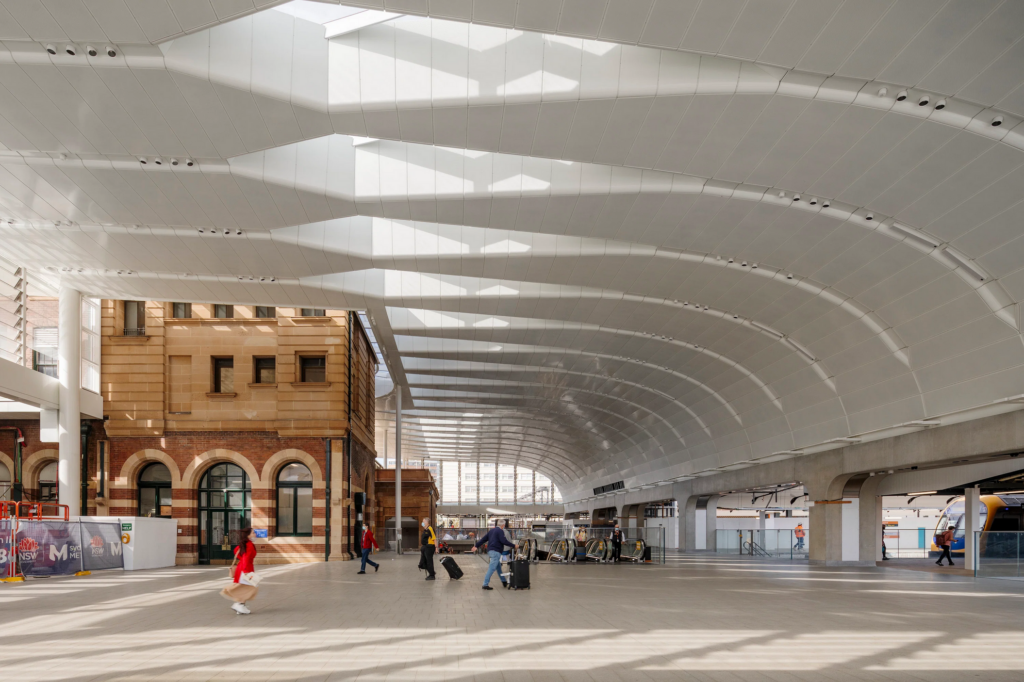
Bit weird department
The Minister of Transport shared a video of himself at the wheel in an effort to counter what he called “weird rumours being spread online by trolls saying I don’t have my driver’s licence.”
“I’m the Minister of Transport – of course I’ve got my full driver’s licence,” he insists, sounding quite miffed. As far as we know, a full driver’s licence isn’t a prerequisite for being transport minister, and a far more important qualification is having good evidence-based transport policies.
Somewhat inevitably, rather than dispelling the rumours, the clip just opened the floodgates on Twitter and elsewhere. Commenters, many of them familiar with the movie business, pointed out that footage filmed from inside a car doesn’t prove you’re actually driving it. Others queried the Minister’s grip on the steering wheel (quarter-to-three versus the traditional ten-to-two) and his checking of mirrors (minimal to non-existent over the course of the 19 second clip).
In the video, the minister says he’s driving on Pakuranga Rd and reminds viewers he intends to revert it to a 60kmh zone. This reminds us that in 2022 as the local MP, he led the charge against a proposed signalised crossing and raised speed table on Pakuranga Rd at a location that sees around 200 hundred bus passengers a day, and where school children cross this six-lane highway. His petition, which gathered 1968 signatures, argued adding a raised table here “is like putting a speed bump on the motorway”:
a particularly bad idea when there are signalised crossings just down the road in either direction, at both the Glenmore Road intersection (approx. 300m away) and the St Kentigern College intersection (approx. 500m away).
Auckland Transport noted that this means a minimum 600m round trip for anyone trying to cross the road safely, but decided not to proceed with the new crossing. (Instead, they planned to monitor the area after the speed limit was lowered to 50kmh. It’d be interesting to hear the results.)
AT on pedestrianising Mercury Lane: computer says “not yet”
Disappointing news just in from Auckland Transport: despite strong public support, it has decided not to pedestrianise Mercury Lane around the CRL station entrance. This is their rationale:
In 2023, we proposed to permanently restrict motor vehicle access on the upper section of Mercury Lane and for Mercury Lane to become a pedestrian mall. 67% of survey participants supported the proposed access changes and 20% opposed. However, when filtered to those who live within the Karangahape neighbourhood, support reduced to 44% and opposition increased to 32%. Following this, we met with directly affected residents, businesses, and property owners to further discuss upper Mercury Lane being a Shared Space or Pedestrian Mall.
In our discussions we heard about concerns regarding access such as concerns that friends, family, visitors, couriers, deliveries and people moving in/out would have difficulty accessing the space. Another concern was that the NZ Police might reduce the number of patrols driving through the area if it was made more difficult.
We would like to inform you that when construction is complete, the upper section of Mercury Lane will open as a Shared Space. The proposal to make this section a Pedestrian Mall has been deferred until after the station opens. The process to create a Pedestrian Mall would once again require appropriate consultation.
The Shared Space will be marked and signposted with a loading zone, but will otherwise be moving traffic only, i.e. no parking. Motorists will only be able to go northbound (uphill) from immediately north of the George Court carpark access and turn left onto Karangahape Road. The signals to operate this will be installed during construction. The road will be two-way between the George Court carpark access and Cross Street.
Bollards will also be installed during construction as planned but not operated. This is to limit further disruption should the area change to a Pedestrian Mall in the future. We still expect very low traffic volumes through upper Mercury Lane.
Interesting that support outweighed opposition even when the focus was narrowed to immediate neighbours, but wasn’t enough to give AT the confidence to proceed. Is this “consultation math”?
You also have to wonder how NZ Police patrol other car-free spaces around the city, like Te Komititanga and Aotea Square.
Anyway, here’s what we won’t be getting any time soon:
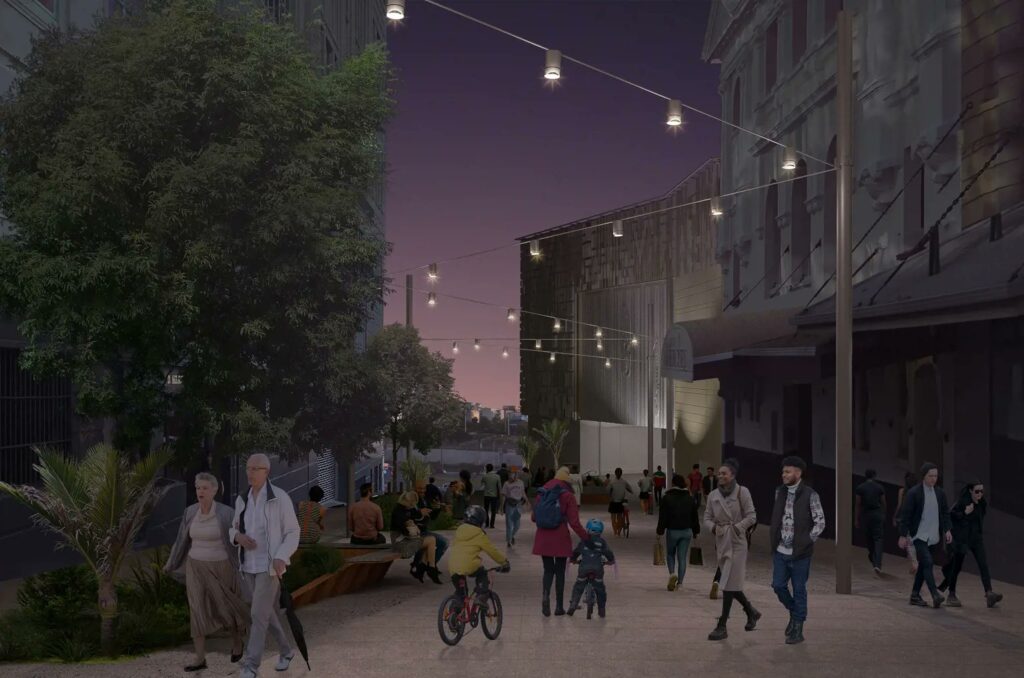
A social media wag quickly whipped up a more accurate render :
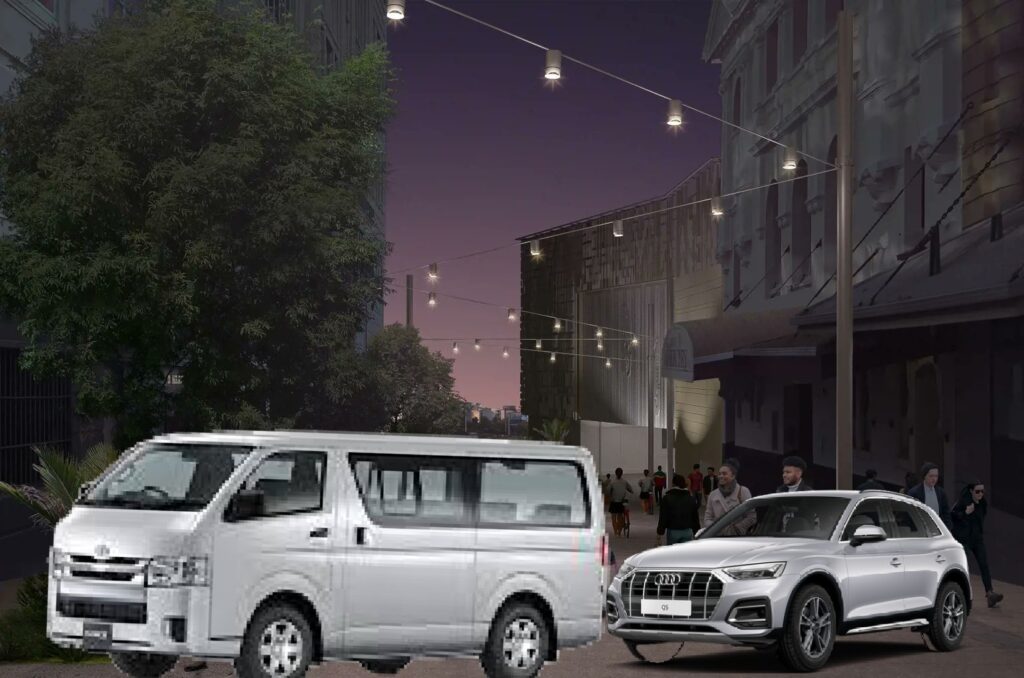
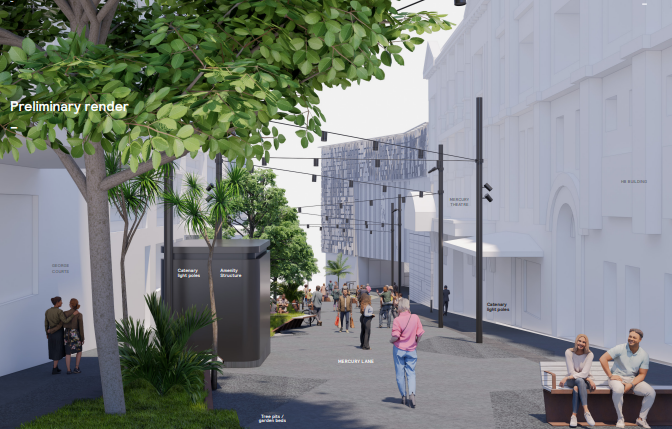
And, in other (dis)appointing Auckland Transport news
It’s musical chairs for the menfolk: the Mayor has swapped out Councillor Andy Baker from his role on the AT Board, replacing him with Councillor Maurice Williamson in what was reported by Bernard Orsman at the NZ Herald as part of a bid to “wrestle democratic control of the council body.”
Williamson is unashamedly pro-car and pro-roads and close to Transport Minister Simeon Brown, who preceded Williamson in the blue-ribbon seat of Pakuranga in 2017.
In turn, Councillor Andy Baker will replace Councillor John Watson as chair of council’s Transport and Infrastructure Committee, which will be renamed the Transport, Resilience and Infrastructure committee.
The Mayor also announced two smaller committees: Councillor Ken Turner will lead a new “parks committee”, and Councillor Angela Dalton will chair a “community committee”.
It was Cr Dalton who, back in May, pointed out the glaringly disproportionate preponderance of men in charge of transport matters for the supercity, with concerning implications for equitable outcomes:
“The transport system has been designed by men and then women need to fit into it. We need to be working together on it,” the Manurewa-Papakura councillor said at the transport committee meeting.
“Women have a different life to men. We are more likely to walk, we are more likely to take public transport, we are more likely not to have access to a car… we have to spend so much time in a system that does not work for us,” Dalton said.
She raised the issue of safety, citing a report by transport planners M R Cagney on “Equity in Auckland’s Transport System” which found women are more likely to consider personal security and the risk of harassment or attack when making travel choices.
Women were surveyed for the report on what changes to public transport would most improve their journeys.
Protected cycleways, more frequent and reliable services, longer operating hours, crime prevention measures – such as greater surveillance and street lights – and lower speed limits and more road crossings were raised, Dalton said.
At the time, the Mayor appeared to take this constructive critique on board:
Mayor Wayne Brown said Dalton raised some good points.
“There are not many women in leadership positions in the transport sector. This is harder to rectify when so many men apply for these roles. I would like to speak with her further about what measures she sees we could be taking to improve the situation.”
Looks like we’ll have to wait for the next merry-go-round to see a wider range of voices at AT’s top table.

Low Traffic Neighbourhoods work and are popular
In the Guardian, a great “told you so” piece by Andrew Gilligan, who was transport advisor to Boris Johnson. And what he’s telling-us-so is: low-traffic neighbourhoods (aka LTNs) are nice, normal, well-supported and working.
If LTNs were bad, they should all have been removed. But by 2023, hundreds of thousands of voters, including many Tories, were enjoying quieter, safer streets, while traffic displacement on to boundary roads had fallen or ended as people made fewer short, local journeys by car.
It follows the “controversy-acceptance cycle” for street, and many other, changes: noisy opposition at the start, albeit usually from a minority, which disappears after a year or two if councils and politicians hold their nerve. (That’s not to say that every single scheme worked and was perfect.)
I was encouraged that Haigh appears to get this. Her promise to “invest on unprecedented levels” will be tested in the budget, but as she clearly understands, cycling could do a lot, very cheaply, for some of Keir Starmer’s core “missions”, including reducing pressure on the health service and growing the economy by getting more people fit to work.
Our local equivalent of the Tories could take note of this bit:
My favourite statistic from Harper’s LTN report was not that, among those who expressed a preference, support for the schemes was double the opposition to them. It was that for all the noise on social media, 58% of voters in LTNs didn’t even realise they lived in one.
Tory activists may hate LTNs, and their friends may hate LTNs – but political parties always get in trouble when they go by what their activists, rather than the public, think. Perhaps, in the years of recovery ahead, the Conservatives will learn this lesson.
Speaking of the “controversy-acceptance cycle”, this illustration of the “Goodwin Curve” is doing the rounds on social media. It shows the gestation process for public acceptance of, in the original example, road pricing schemes. It’s widely applicable to all kinds of good stuff.
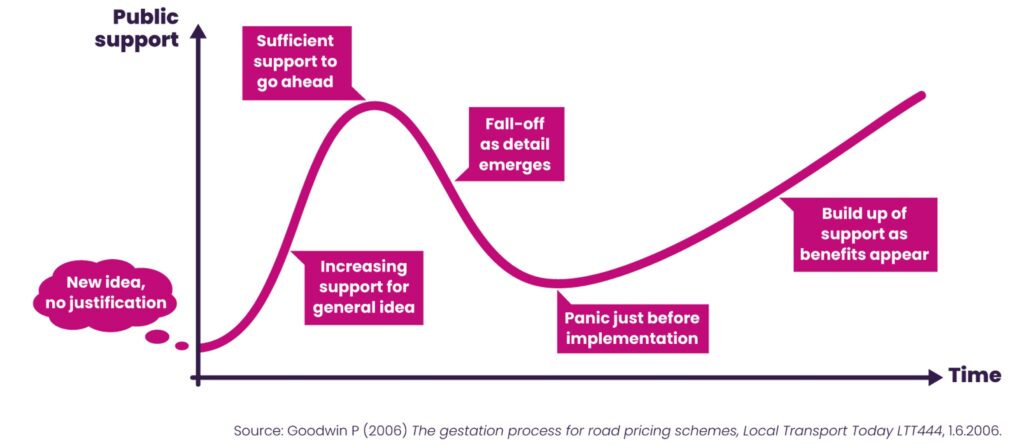
Bikes are the business
Another instalment in the Spinoff’s Big Day Out (Bike Bike) series, this time featuring Matua Murupaenga on some of his favourite routes.
“I feel like riding bikes is the most sensory intense form of transport,” he says. “On a super light road bike with thin tires, you feel like you’re floating on top of the road.” Matua also reckons that bikes are a great way to explore, especially with friends: “It’s a good, active way to get to new places, a pretty cool thing to do with other people.”
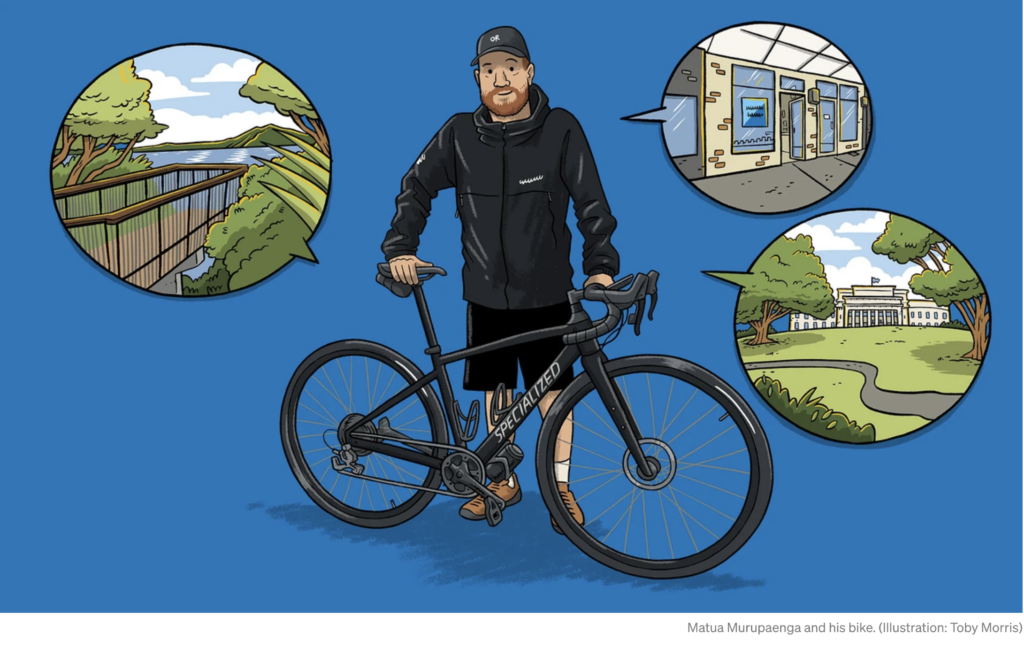
And an AT-sponsored article in the Herald’s Viva magazine invites you to “explore Auckland’s inner-west suburbs by bike“, including Waterview, New Lynn, and:
Pt Chev, the charming peninsula suburb where you’ll find plenty of good riding, especially now the brand-new cycle path on Meola Rd leads all the way to Pt Chevalier Rd.
Which is true, it’s fabulous – if you can dodge the people who’ve decided to park on it and/or drive along it.
A lovely read from Wellington by James Barber describes cycling to the cemetery (for historical reasons), via one of the city’s newest cycleways:
The cycleway to the Botanic Garden and then Karori follows part of the route of two different awa. The Pipitea awa flows down Glenmore Street and Tinakori Road. It is this which feeds the duck pond and is the stream you go to if you want to see the glow worms at the Botanics. It then flows through Pipitea Thorndon. Having looked at the maps it might even go under my work, before coming out at the wharf near the cake tin. It was originally one of several which would reach the harbour at what is now Thorndon Quay.
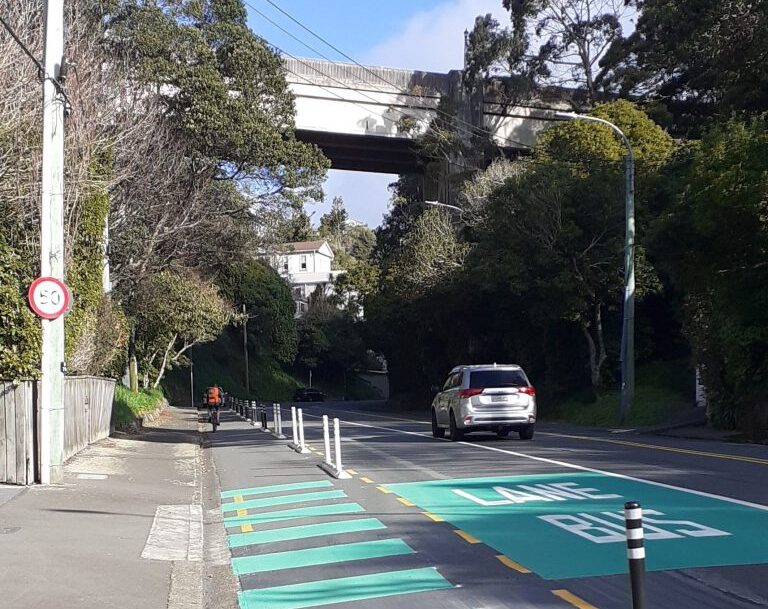
And in Christchurch, an unusual vehicle (see video here) Spotted beetling around has been identified as a Quatrevelo from Velomobile. It’s the pride and joy of Hadley Pettigrew, who imported it from the Netherlands:
Hadley says the velomobile removes his excuse for not biking in the rain, easing safety concerns regular bikes have.
“I’ve been knocked off [my bike] a few times.”With extra luggage space, four wheels and an aerodynamic safe outer shell, Pettigrew says it makes a “good replacement car.” Racing at speeds 30km/h on standard roads, or if he’s really trying, 40km/h, the green velomobile has captured the public’s attention.
Pettigrew said people whip out their phones, smile or even yell when they see the green machine.
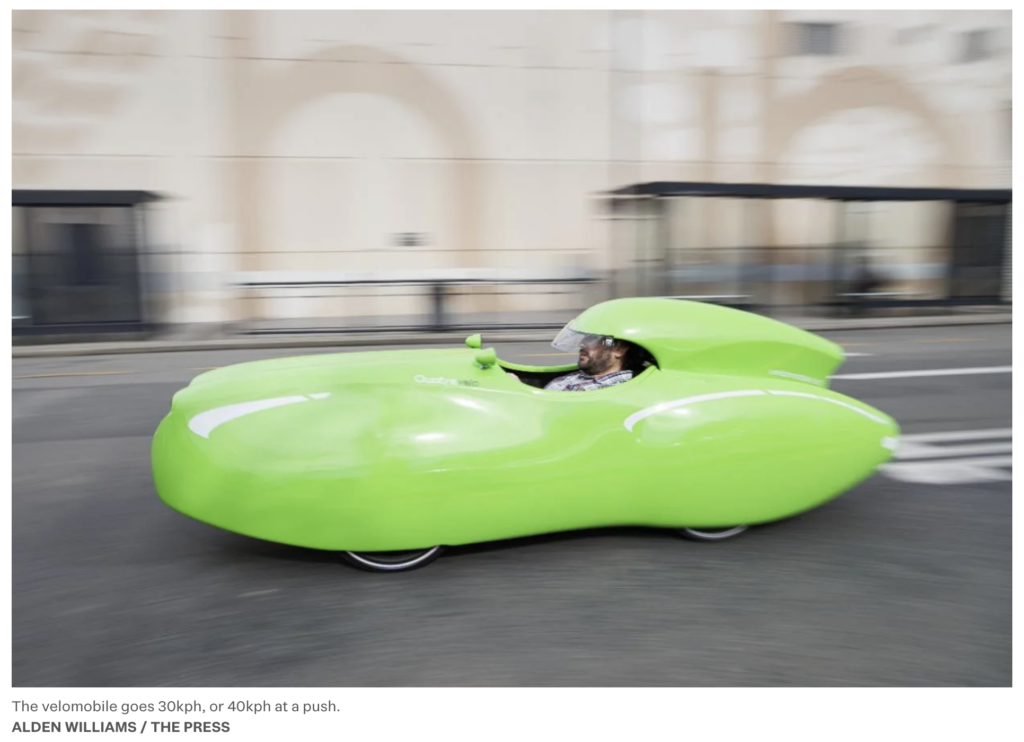
Speaking of four-wheeled cycling: here’s a pedal-by-wire electric cargo-cycle quad bike, featured at last month’s Eurobike show, which can haul up to 1000 pounds (around 450kg) of freight. Mighty stuff!
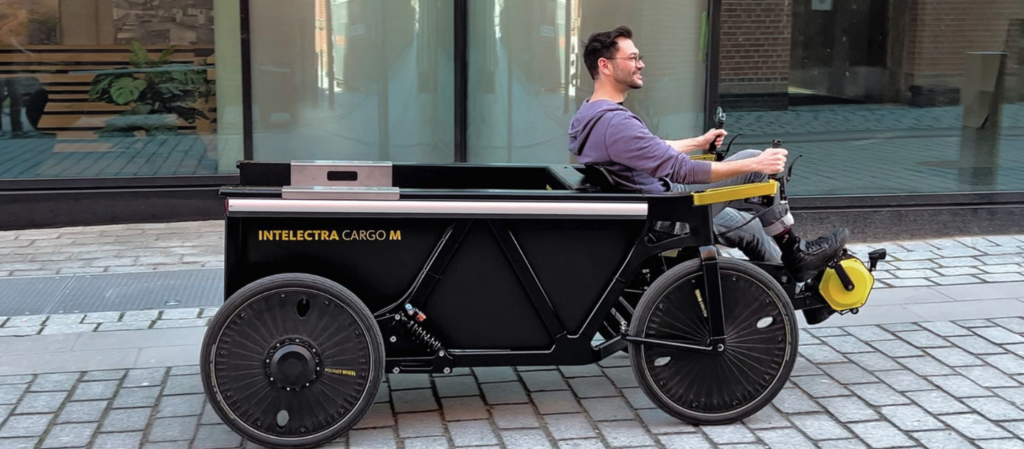
Are we there yet? Kua tae atu tātou?
What’s happening with bilingual road signs? asks Karanama Ruru for Stuff. A good question: it’s been over six months since the Minister said a decision was “coming soon“. While we wait, Ruru took the question to the people:
A Stuff tiki tour testing the community’s appetite for proposed bilingual road signs, including in the heart of ACT leader David Seymour’s Epsom electorate, has revealed strong support for making reo Māori part of our everyday journeys.
It comes as Aotearoa awaits a decision from Transport Minister Simeon Brown on the future of He Tohu Huarahi Māori, a million-dollar project that would gradually replace road signs across the country with 94 potential new signs in te reo Māori and English.
The article presents a range of views, as this government is wont to say – and all but one are strongly supportive. Here are a couple:
[I]n Newmarket, Ali Atarodi said road signs in Iran, where he comes from, are in both Farsi and English, and this proposal was no different to what he was used to.
He supported bilingual signs for New Zealand.
“It’s better to protect the local people. It’s their land and we must respect them,” he said.
Atarodi has been living in New Zealand for a year-and-a-half. He said the signs would help Māori feel more confident in speaking and using te reo.
“I know that the formal language is English, but for many people, it’s their land. [It’s] about respect.”
Arihia Turei said she supported the introduction of bilingual signs, and had some advice for anyone who might find them confusing.
“It has, like, what it means on it – Māori, and then the translation down the bottom – it’s not that hard.”
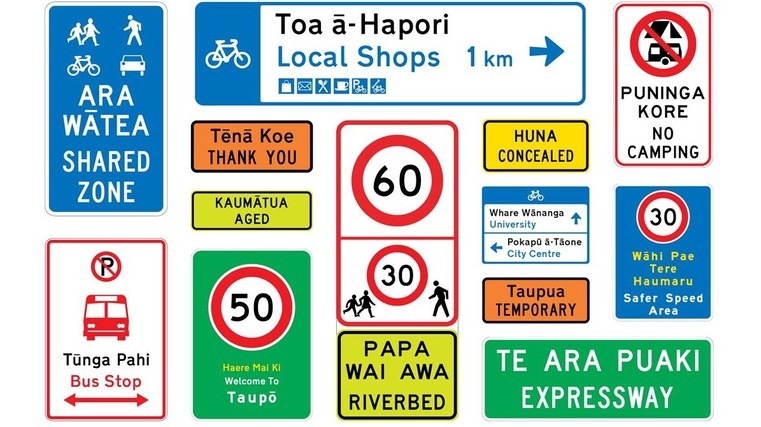
Some fixes to parking fines
Here’s something from the government we can get behind. After successive governments over multiple decades failed to update parking fines, this government have dipped their toes in the water by increasing the fines for parking in a disabled carpark. In October, fines will go from $150 to $750. In addition, the fees paid for vehicles that are towed will also increase – they were so out of date that it cost more to tow a car than was covered by the fee, so councils and agencies like Auckland Transport rarely use it as an enforcement option.
Now, if the government could just update the other parking fines – as we’ve previously covered, if they’d kept pace with inflation they’d be around 80% higher – that would help. And then they could take a look at the fines for speeding, phone use, etc, which are well out of step with our peers – that’d be a quick and proven way to boost road safety as per their stated ambitions.
That’s us for the week – as always, drop your thoughts and links in the comments below. Have a lovely weekend, roll on September (the month of Te Wiki o te Reo Māōri), and welcome to Spring!



 Processing...
Processing...
The backtrack on the Mercury Lane pedestrian mall is very frustrating.
CRL is a multi billion dollar investment, we must do a good job of redeveloping the areas around the new stations to maximise that investment, and yet a minority of the existing residents who submitted can veto that? Crazy stuff.
We need to accept that it is OK if existing residents of an area oppose redevelopment which has broader support and objective benefits for liveability, safety, and economic development. Buying property somewhere does not commit society to keeping that place exactly as it was when you purchased it, particularly in the underdeveloped economic engine of our city and country. Don’t like it? Take your capital gains and move.
It’s so ridiculous. Just do it from the outset and stop consulting with everyone. In 6 months time once opened no one will even care
Also where are all those “democracy” commenters? If something has more support than opposition shouldn’t it be approved..
“We still expect very low traffic volumes through upper Mercury Lane.” – how do they write this crap with a straight face. it will be yet another crap shared space like nearly all the other ones in town.
“Also where are all those “democracy” commenters? If something has more support than opposition shouldn’t it be approved.”
Ah, but then they’d have to build bikeways. Even the “controversial” Grey Lynn bikeways get positive support every time, until they’d have to argue that “Looking at only these 5 submitters closest to this intersection, 3 of which are opposed, we had to sadly cancel the project despite it aligning with our policies”.
That’s because they only selectively believe in “democracy” when it supports their beliefs and their privileges.
How long it will stay like that is not certain. A lot of extra expense to put in a signal phase that will take out valuable time from Pitt/K Rd intersection, which will be used by heaps of people to and from the station as well as all the bus passengers on WX1 and the rest.
Great point and something a lot of our roads suffer from because they have so many car movements, with few one way roads which are way faster to cross for pedestrians.
Surely Mercury Lane would be one of the last places that should be pedestrianised. A grotty south-facing steep little street to practically nowhere at all. Yes there will be an entrance to a station there but that isn’t necessarily going to lift the amenity of the area.
Tedious
“A grotty south-facing steep little street to practically nowhere at all.”
No need for cars then, by the sound of it.
Hadley needs to pedal a bit harder – velomobiles can rip along at 40-50 quite easily.
On bilingual signs:
I hope they go ahead with the requirement for some visual distinction between the two languages.
In the examples above the “Taupua/TEMPORARY” sign feels more legible than the “HUNA/CONCEALED” one and the multicoloured wayfarering & speed signs more legible than either of those.
Agree, BSD – the distinction in colour and/ or font really helps with clarity, and maybe also with learning and retaining new words. A good thing all round.
Quintessential NZ thinking sadly. No-one has tried this before, we are special and will No8 wire the solution, rather than, let’s just copy a good example from another country. Multiple countries have come to the same conclusion of:
Standard font above
Italic font below
As much as I like Hanlon’s Razor, the cynic in me thinks this is being done to make the signs unpopular.
I agree, eg the Irish road signs with italic gaelic, and english below, are clearer than the Welsh road signs with the same typeface for both.
I have Dyslexia and find driving difficult enough (hence I use public transport a lot). If they do bring out bilingual signs I wish they would put English up the top, then Te Reo underneath – easier to read top down in a hurry.
Given in the future computers not humans will increasingly be the ones reading these signs moving to a single worldwide convention based iconography not language would seem the best solution (combined with direct digital transmission of the same information). Worldwide conventions are hard to bring in so alternatively aligning our signage with that of a major automotive market that has already achieved good standardization will mean that driver assistance packages and autonomous vehicle systems don’t need to be designed and tweaked for some unique New Zealand only signage. If we go to a unique New Zealand only system such systems will likely fail to correctly recognise signage at higher rates than if we had aligned our signage with a market of several hundred million consumers where testing and learning will be much more easily done across millions of deployed vehicles. Either that or vendors will be slow to introduce innovation in our market and vehicles so equipped will be more costly due to extra system training and testing required for a very limited total market size.
Establishing congruence with overseas signage seems like a much better goal with much stronger benefits for New Zealand consumers than developing a New Zealand only scheme.
Who are these residents on K Road who need car access? I can’t imagine many residents on K Road HAVE cars? This is a classic ‘the results didn’t go how we wanted so we’ve changed the criteria’…absolutely pointless as they will have to change the paving to be stronger to allow for cars, only to ban cars in a year. I’m sure whoever sells the strong concrete pavers is laughing.
As for the Sydney Metro, it makes me sad. I was talking about it to a few collegues at work and joked that and here we are struggling to build a buslane and they all chip in with ‘well Sydney is 6 million people’ and ‘we don’t have the density in Auckland’ and ‘can’t afford thse things’ I went on to tell them Cities in Europe for 1/5th population of Auckland are rolling out light rail and we’ve spent billion on roads. Kiwis are such backwards thinkers…
Who are these residents on K Road who need car access? I can’t imagine many residents on K Road HAVE cars? This is a classic ‘the results didn’t go how we wanted so we’ve changed the criteria’…absolutely pointless as they will have to change the paving to be stronger to allow for cars, only to ban cars in a year. I’m sure whoever sells the strong concrete pavers is laughing. As for the Sydney Metro, it makes me sad. I was talking about it to a few collegues at work and joked that and here we are struggling to build a buslane and they all chip in with ‘well Sydney is 6 million people’ and ‘we don’t have the density in Auckland’ and ‘can’t afford thse things’ I went on to tell them Cities in Europe for 1/5th population of Auckland are rolling out light rail and we’ve spent billion on roads. Kiwis are such backwards thinkers…
“Bollards will also be installed during construction as planned but not operated.”
Maybe the bollards can do a “Wynyard Bridge “, and refuse to retract.
I read the thing, I think that’s the key point. At any point later on they can change it for near 0 cost or time (as I’m sure they’d find a way to spend hundreds of thousands on metal signs).
But it costs more from the offset to pave for cars vs people due to types of pavers etc
Not really hard to guess. Most likely some mates of ATs management.
I did read the older consultation reports or whatever on this. There is some car parks in the apartment building there, from memory George Courts old building. So themselves plus visitors, couriers, servicing vehicles etc for an old building, detailed issues of limited turning around arcs, loading zone things and such. They could of just gone the longer way around via the shared spaces etc is the issue. So be interesting the amount of cars to pedestrians ratio after CRL opens. Hopefully it will work out to have just access from the lower bits or the traffic count is so low we are all happy.
Good on Simeon, Can’t wait for the Pakuranga rd speed limit to be reversed back to 60k!
Why? It is a residential suburban street, how is that compatible with 60?
Would 60 make any significant difference to travel time?
Or why not 80?
Because in Australia it’s normal for these type of roads to have a 60 or 70k speed limit. The road toll over there is lower = faster is safer. Also it’s not a “residential street” it’s a major suburban highway! It’s used to transport thousands to the outer eastern suburbs. 70 would be a better speed limit but we will take what we can get. Dont have any time for the 30k rubbish sorry, want to get where we need to go as quickly as possible.
Who is we?
good luck going 70k in gridlock, pal. though I suppose you’ll somehow blame public transport for NACT’s petrol huffing ineptitude
Oh Burrower typical assuming, where did I say I hate PT? Clearly wouldn’t be reading this blog if I was against. I’m pro “quick” journey times in general whether that be for PT or for Cars or for Bikes. Everyone deserves a fast as possible journey. Also never drive on Pak rd at peak time only interpeak or weekends so wouldn’t know of any gridlock issues.
On that road it would save them just over a minute if they were able to maintain the maximum speed of 60 km/h for the whole stretch.
Given that is impossible, I would estimate the average saving to be less than 45 seconds when there is no traffic on the road.
With traffic, the saving would be even less.
That’s of no concern to Quickly though…
A minute is huge Wilbert. Huge. You may not see it as much time but some of us do and appreciate being able to save those precious seconds. You do realise in some cases it’s saves much much more than a minute take for example missing 2 sets of green lights at 60k you could’ve cleared the lights while at 50 you just miss the lights making the time difference huge! Also 50k has taken the joy out of driving Pakuranga road lol.
A minute is HUGE, just think of all those minutes Simeon would get back that he could use to read reports and follow evidence?
Yes, kill the kiddies and keep the signals red for longer for clearance times.
You’ve said they should update other parking fines. It looks like they actually are. It’s in the amended schedule 1b for the regulation and the press release you linked to did say they are doing this. It’s not much of an increase (70%) supposedly, but it’s something.
https://www.legislation.govt.nz/regulation/public/2024/0179/latest/LMS984142.html?search=ts_act%40bill%40regulation%40deemedreg_Land+Transport+(Offences+and+Penalties)+Amendment+Regulations+2024_resel_25_a&p=1
Yes, it was reported yesterday by RNZ:
https://www.rnz.co.nz/news/political/526499/big-increase-in-penalties-for-misuse-of-disabled-parking-spots
Wow, they are going up, if 70% that pretty close to the 80% inflation amount as per that old blog post.
An interesting week for democracy. The winners of a popularity contest (election) claim the right to enact whatever they choose, rather than ask the people what to do on any particular thing. Rich, old, white males since 1841 decide what is good, with a few young, aspiring people who generally agree with them.
It’s hard not to comment politically when politicians are saying what we see this week.
Consulting with people (inform, suggest, listen, reach agreement), with the help of governance to ensure things are done correctly and well, would seem more democratic. Especially ensuring that we inform and listen to those who are disadvantaged or disenfranchised in any way, or have the advantages of different gender, age or culture.
Mercury Lane thing is so bizarre. It seems like they put out something good by accident then look at the survey and got scared that people actually want them to do their job. Then tried skewing results somehow more in their favour. Yet it still wasn’t there so they organised in person session probably sending invitations to all the opposing parties and finally got their outcome and reason not to do it. Useless
Is there anything less surprising that drivers parking all over the footpath and verge along Meola Road once the cycleway is open. AT should be able to fund themselves for years with the parking tickets
Hey Matt / Greater Auckland
Maybe move the week that was a day or so later to catch the Friday news dump (you know where contentions issues get buried at the end of the week)
Yesterdays dumpster fire was the “scrapping” of NZTA’s “dedicated road safety team”. Its normal to disestablish teams when they have achieved their goals i guess, but this is a cost-cutting measure. A “safety director” will be installed.
https://www.rnz.co.nz/news/political/526577/nzta-scraps-dedicated-road-safety-team-as-part-of-government-cost-cutting-drive
I was under the impression we knew this was coming when they were consulting on speed limit reversals. It’s a good sign it means the speeds are going to be reversed and no one can stop it. Just announced today more speed increases, finally getting back the joy of driving we lost. Roll on the reversals!
Isn’t an electro cargo quad ‘bike’ just like a modern take on a vintage car? if it looks like anything it looks like Henry Ford’s Quadricycle. You can bet pretty soon the vendors will start adding enclosed cabins, air conditioning, space for 4 passengers, entertainment systems and a bike rack on the back.
With its 500kg+ GVM it weighs more fully loaded than a Fiat Bambina. It probably needs an option for a plow on the front for gently shunting slower and lighter road users off mixed use paths and out of cycle lanes.
” .. the Mayor has swapped out Councillor Andy Baker from his role on the AT Board, replacing him with Councillor Maurice Williamson …”
What the absolute f#!@$%*!. National Party, Pakuranga, Simeon & Maurice, why, why, why they like this?! Getting rid of those crossing plans on the highway, tisk, tisk, tisk. Total child killing dorks.
And those cars parked on cycleway, hope their putting up the fines soon, like the assessible parking spot ones from 1 October, from $150 to $750.
Maurice says he’s a data / evidence based person, so he should eventually be convinced by the solid science on this sort of stuff.
Be interesting how this goes:
“Auckland Mayor Wayne Brown and Transport Minister Simeon Brown are working on a new governance structure for transport in Auckland.”
Would an electable AT board be what they are doing and be the answer for accountability? The whole idea of the AT CCO was to removed it from petty politics and make them do work more based on science and data from what I understand.
I think voting for these board members would have quite a good engagement though for NZ’s largest city by far. If it ends up like the health board member voting we do though I’m a bit worried as I don’t think many know who the people are at local election time. We read one paragraph summary on them in a little booklet and decide. from that.
This video some reading might find interesting:
https://www.youtube.com/watch?v=z0C7rb9a4mk
How to Fix One of the Most Famous Traffic Chokepoints in the U.S. and other similar intersections and the reason they are like that.
An infamous interchange in Breezewood, Pa., forces drivers through a roughly 2.5 mile-long detour. The route connects Washington DC and Baltimore with Pittsburgh and goes all the way through the Midwest.
* readers
Another one, YouTube Short:
https://youtube.com/shorts/JXEerVae3Ik?si=ql0KCUEQK3GLrQ6e
Can we split the super city into two – Pakuranga (the super shit city) and the remaining super city. All that money we are currently wasting on AMETI could be used to build something decent for people who actually want it and don’t vote for dickheads.
Now, obviously Auckland trains are better than other buses, so can we install more train shops at train stations so we can buy more AT train merch? I mean, it’s what we need as a AT family. Memorable s that we can hang on our fridge and key chains and so forward.